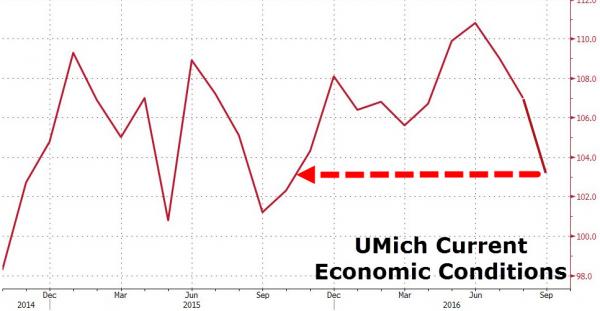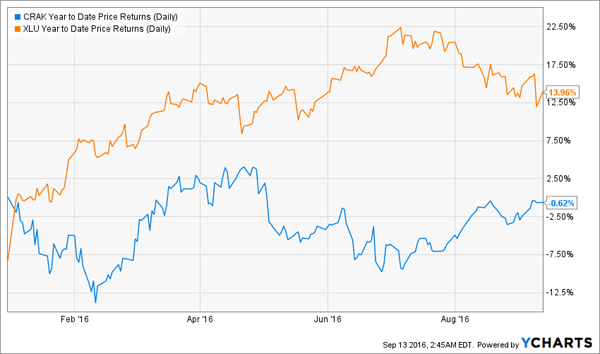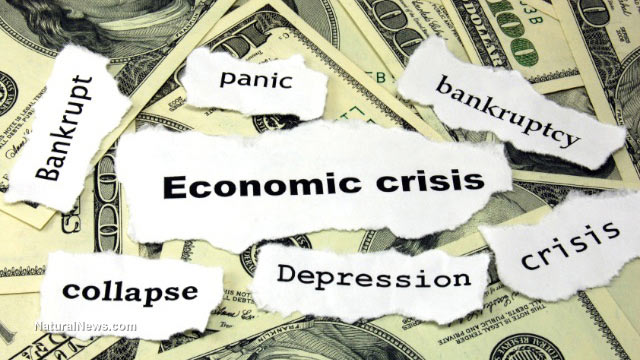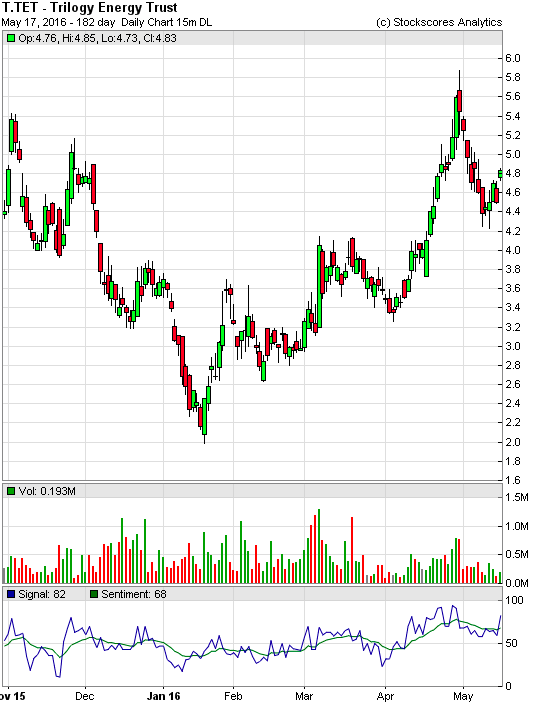Economic Outlook
University of Michigan survey results show Current Economic Conditions plunged to 103.5 – the lowest since Oct 2015. The biggest driver of this weakness is tumbling inflation expectations (with 1Y outlook dropping to 2.3% – the lowest since Sept 2010).

Confidence was unchanged in early September from the August final and barely different from the July reading.
…related:

I want to talk about a corner of the market that has been overlooked for far too long despite offering sustainable high yields of 4% or more—with dividends primed to soar even more.
This sector is a distant cousin to a more familiar group of stocks: utilities. Utility stocks were once Wall Street’s best kept secret: high dividends, cheap valuations, sustainable business models, and steady revenues were all reasons why many big investors quietly bought these small regional companies. Sadly, the cat’s out of the bag. Utility stocks are up nearly 14% year-to-date as investors pile into the sector:
Utilities Gone Haywire

Just look at the performance of the SPDR Utility ETF (XLU), which is up massively even after a recent correction from its shocking 22% year-to-date return earlier this summer. But notice the other line in that chart—that’s the VanEck Vectors Oil Refiners ETF (CRAK), a new and tiny ETF that tracks the oil refineries sector. This ETF is new and tiny for one simple reason: the market has ignored refineries even as it has a love affair with utilities..…continue reading HERE
…also Michael Campbell on – The Formula For Social Unrest & Political Upheaval

 Quantitative Easing (QE) is a risk. Negative Interest Rate Policy (NIRP) is a big risk. Governments using the threat of terrorism as an excuse to dramatically increase their own powers and reduce individual freedom is a huge risk. X hundred trillion dollars of notional derivative value is meaningless.
Quantitative Easing (QE) is a risk. Negative Interest Rate Policy (NIRP) is a big risk. Governments using the threat of terrorism as an excuse to dramatically increase their own powers and reduce individual freedom is a huge risk. X hundred trillion dollars of notional derivative value is meaningless.
The hundreds of trillions of dollars of notional derivative value and the associated counterparty risk is a potential life-threatening problem for some of the major banks, but if you believe that derivatives are like a sword of Damocles hanging over the global economy then you’ve swallowed the propaganda hook, line and sinker. The claim during 2008-2009 that the major banks had to be bailed out to prevent a broad-based economic collapse was a lie and it will be a lie when it re-emerges during the next financial crisis.
The global economy could easily handle JP Morgan, Goldman Sachs, Bank of America, Citigroup and Deutsche Bank all going out of business. The shareholders of these companies would suffer 100% losses on their investments, the bondholders of these companies would suffer substantial ‘haircuts’, most employees in the investment-banking and proprietary-trading parts of these companies would lose their jobs, but it’s unlikely that depositors would be adversely affected as the basic banking businesses would simply come under new management. Furthermore, while there would be short-term disruption, Apple would continue to sell loads of iPhones, Exxon-Mobil would continue to sell loads of oil, Toyota would continue to sell loads of cars, and both Walmart and Amazon would continue to sell loads of everything. Life would go on and in less than 12 months most people would not notice that some of history’s banking behemoths had departed the scene.
The real economic threat posed by derivatives is that when there is a blow-up the central banks and governments will swing into action in an effort to keep the major banks afloat. Rather than doing nothing other than ensuring that there is a smooth transfer of ownership for the basic banking (deposit-taking/loan-making) parts of the businesses, we will likely get a lot more of the policies that transfer wealth from the rest of the economy to the banks. That is, we will get a lot more price-distorting QE and programs similar to TARP.
The justification will be that saving the banks is key to saving the economy, but in reality the biggest threat to the economy will come from the policies put in place to save the banks.
…..related: Michael Campbell on – The Formula For Social Unrest & Political Upheaval


The World is upside down. For 5000 years investors have been paid an interest rate to compensate for the risk and for the use of the capital. Now, thanks to government incompetence in financial disasters, we now paying government for the privilege of using our money!
…..related: Michael Campbell on – The Formula For Social Unrest & Political Upheaval














